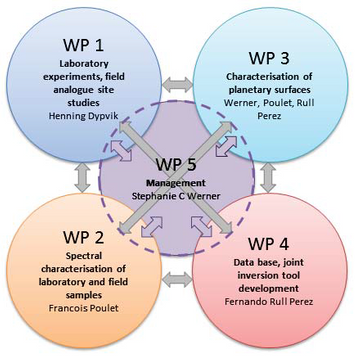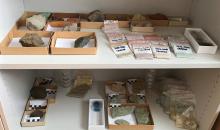Work Packages

WP1 - Laboratory Experiments, Field Analog Site Studies:
This WP led by University of Oslo (UiO) combines field campaigns to collect a variety of fresh and altered samples providing a broad spectral database for the natural and artificial primary lithologies and weathering products from Earth. In addition, selected samples will be reacted to further understand the formation of alteration phases at strictly controlled conditions in laboratory experiments.
You can find some results of WP1 on this page.
WP2 - Spectral characterisation of laboratory and field samples:
This WP is led by University Paris Sud (UPSud), and will provide the spectral characterisation of the natural and artificial mineral samples with the individual instruments (located at UPSud/IAS, IRAP, and UVA), either prototype or flight spare, deployed on the different active and future landers, and individual procedures to allow the full scientific exploitation of the spectra.
You can find some results of WP2 on this page.
WP3 - Spectral characterisation of planetary surfaces from orbital and landed platforms
PTAL is to build a multi-instrument spectral database of natural and experimentally produced minerals. The base for this library is collected and observed within WP1 and WP2, while the actual library is set up in WP4. WP3 shall allow the team to make use of the new spectral information and apply them to space-based measurements of ongoing lander and orbital missions as well as missions, which will deliver data during the course of the project. The main goal of this WP is to produce jointly a high number of scientific publications based on European and international space data. We will try to address the aqueous history of Mars specifically, and the detection of alteration minerals specifically, and deriving tentatively periods of habitability, conditions for developing precursors of life.
You can find some results of WP3 on this page.
WP4 - Spectral Library of IR, Raman and LIBS
The WP is led by the University of Valladolid (UVA). The main aim of the database is to allow the use of spectra stored for purposes related with comparison, identification, quantification and spectral calculation when spectroscopic instruments IR, Raman and LIBS operate in planetary missions and/or analysing materials in the field or in the laboratory. The spectra need to be classified in close correlation with the samples from which they were obtained.
WP5 - Management and Dissemination
This WP is led by the University of Oslo (UiO) as coordinator and main contact point for the European Commission.



